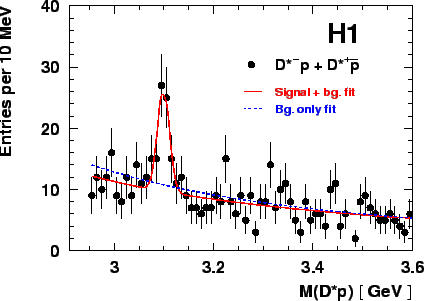 |
 |
Since the year 2003 several experiments have reported the observation
of a narrow resonance in the ![]() channel at mass values around
1540 MeV [232].
The minimal constituent quark content of such a state is
channel at mass values around
1540 MeV [232].
The minimal constituent quark content of such a state is
![]() .
These measurements, supported by similar observations in the
.
These measurements, supported by similar observations in the ![]() channel [233], were interpreted as evidence for a pentaquark state.
ZEUS performed searches for resonances decaying into
channel [233], were interpreted as evidence for a pentaquark state.
ZEUS performed searches for resonances decaying into ![]() [53] and found
a signal of around 1520 MeV which has a probability of being a statistical fluctuation
of the background of
[53] and found
a signal of around 1520 MeV which has a probability of being a statistical fluctuation
of the background of
![]() .
No signal was found for the final state
.
No signal was found for the final state ![]() [54].
In analogy a charmed pentaquark state, with minimal quark contents
[54].
In analogy a charmed pentaquark state, with minimal quark contents
![]() as predicted in [234]
might lead to an observable signal in the
as predicted in [234]
might lead to an observable signal in the ![]() invariant mass combination.
H1 [51] and ZEUS [52]
have investigated their data for signals and found different results.
invariant mass combination.
H1 [51] and ZEUS [52]
have investigated their data for signals and found different results.
H1 reports evidence for a resonance observed when studying
the invariant mass combinations of ![]() (
(![]() ) with protons (
) with protons (![]() )
and the anti-matter equivalent,
)
and the anti-matter equivalent, ![]() mesons with anti-protons.
A strong signal is observed at a mass of 3099 +/- 6 MeV,
containing roughly equal contributions from
mesons with anti-protons.
A strong signal is observed at a mass of 3099 +/- 6 MeV,
containing roughly equal contributions from ![]() and
and
![]() combinations above a moderate background (fig.51).
The resonance, corresponding to a minimal quark composition
combinations above a moderate background (fig.51).
The resonance, corresponding to a minimal quark composition
![]() is
produced along with other particles in DIS events.
The fraction of events in the
resonance peak compared to the number of
is
produced along with other particles in DIS events.
The fraction of events in the
resonance peak compared to the number of ![]() events is about 1%.
The probability that a background of
events is about 1%.
The probability that a background of ![]() events
fluctuates to produce at least the number of events in the signal
is
events
fluctuates to produce at least the number of events in the signal
is
![]() , assuming Poisson statistics. This number corresponds
to 5.4
, assuming Poisson statistics. This number corresponds
to 5.4 ![]() when expressed as an equivalent number of Gaussian
standard deviations.
when expressed as an equivalent number of Gaussian
standard deviations.
ZEUS has performed a similar analysis and found no indication for a
signal [52].
An upper limit on the fraction of ![]() mesons originating from
a resonance decay in the mass region around 3.1 GeV was calculated to
be around
mesons originating from
a resonance decay in the mass region around 3.1 GeV was calculated to
be around ![]() .
There is hope that the apparent contradiction between the two
experiments will be resolved
with improved statistics and a more detailed analysis of the
properties of the observed signal.
.
There is hope that the apparent contradiction between the two
experiments will be resolved
with improved statistics and a more detailed analysis of the
properties of the observed signal.